
Old FrieNds In NebrAska; Mesostics on the Introduction to "My Ántonia"
Created by Martin Dowling and Published by Triangular Press, Portland 2019
This text, a ‘mesostic’ of the introduction to Willa Cather’s My Ántonia, was created by Martin Dowling using a score by John Cage, a treatment which creates a kind of core sample of a given text. His score was first published in Cage: Roaratorio; Laughtears—Cage, Shöning, Heaney, Ennis, et. al; Writing for the Second Time Through Finnegan’s Wake (New York: Mode Records, 28/29, 1992).
This project was generated by the MesosticMachine, a program developed by Dowling.
Willa Cather’s novel is its first project.
(https://github.com/mwdowling/MesosticsMachine-2018).
(http://www.gutenberg.org/ebooks/242
Having created Roaratorio: An Irish Circus on Finnegan’s Wake, a musical realization of James Joyce’s Finnegan’s Wake, artist and composer John Cage published a set of instructions for the musical realization of any literary work. In 2012, Martin Dowling collaborated with sound artist Úna Monaghan to create a musical realization of the memoir of Belfast, Northern Ireland poet Ciaran Carson called Owenvarragh: A Belfast Circus on The Star Factory. Subsequently, Dowling created a software programme called the MesosticMachine to assist in the implementation of Cage’s score. Integral to the score is the creation of a series of “mesostics,” poems generated from a text according to an algorithm devised by Cage. The MesosticMachine generates a first draft of these poems from any electronically formatted text, for example any novel in the Project Gutenberg database. These can then be sculpted into their final form, ready for recitation and incorporation into a musical realization.
For a more detailed account of the score and its implementation, see the essay and portfolio by Dowling and Monaghan published in a special Cage issue of the Black Mountain College Studies Journal, volume 4.
This project was set in linotype Caledonia by Stumptown Printers and printed onto Japanese paper and wound around a wooden dowel. All production by Barb Tetenbaum at Triangular Press.
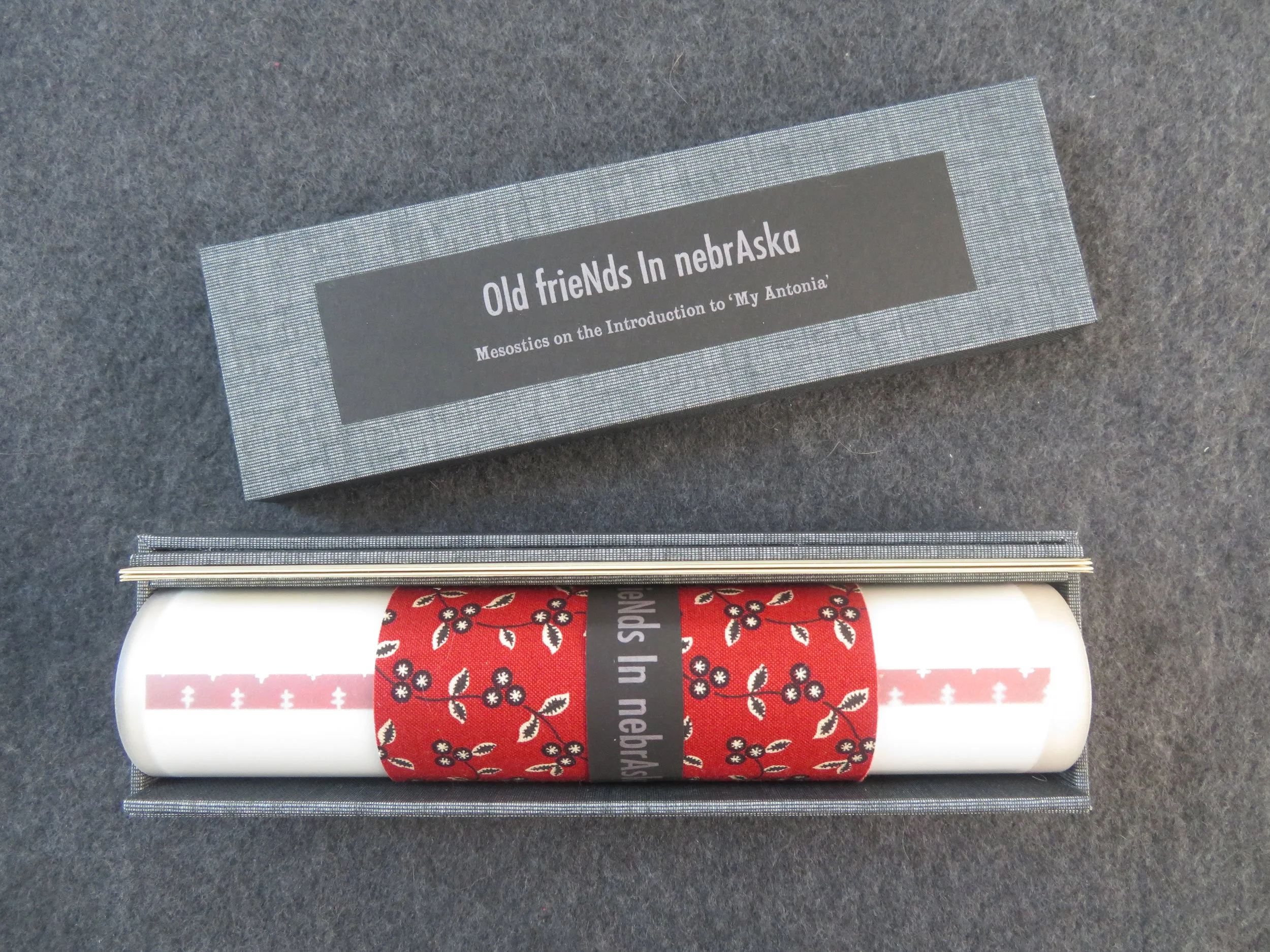
Old FrieNds In NebrAska; Mesostics on the Introduction to "My Ántonia"
Created by Martin Dowling and Published by Triangular Press, Portland 2019
This text, a ‘mesostic’ of the introduction to Willa Cather’s My Ántonia, was created by Martin Dowling using a score by John Cage, a treatment which creates a kind of core sample of a given text. His score was first published in Cage: Roaratorio; Laughtears—Cage, Shöning, Heaney, Ennis, et. al; Writing for the Second Time Through Finnegan’s Wake (New York: Mode Records, 28/29, 1992).
This project was generated by the MesosticMachine, a program developed by Dowling.
Willa Cather’s novel is its first project.
(https://github.com/mwdowling/MesosticsMachine-2018).
(http://www.gutenberg.org/ebooks/242
Having created Roaratorio: An Irish Circus on Finnegan’s Wake, a musical realization of James Joyce’s Finnegan’s Wake, artist and composer John Cage published a set of instructions for the musical realization of any literary work. In 2012, Martin Dowling collaborated with sound artist Úna Monaghan to create a musical realization of the memoir of Belfast, Northern Ireland poet Ciaran Carson called Owenvarragh: A Belfast Circus on The Star Factory. Subsequently, Dowling created a software programme called the MesosticMachine to assist in the implementation of Cage’s score. Integral to the score is the creation of a series of “mesostics,” poems generated from a text according to an algorithm devised by Cage. The MesosticMachine generates a first draft of these poems from any electronically formatted text, for example any novel in the Project Gutenberg database. These can then be sculpted into their final form, ready for recitation and incorporation into a musical realization.
For a more detailed account of the score and its implementation, see the essay and portfolio by Dowling and Monaghan published in a special Cage issue of the Black Mountain College Studies Journal, volume 4.
This project was set in linotype Caledonia by Stumptown Printers and printed onto Japanese paper and wound around a wooden dowel. All production by Barb Tetenbaum at Triangular Press.



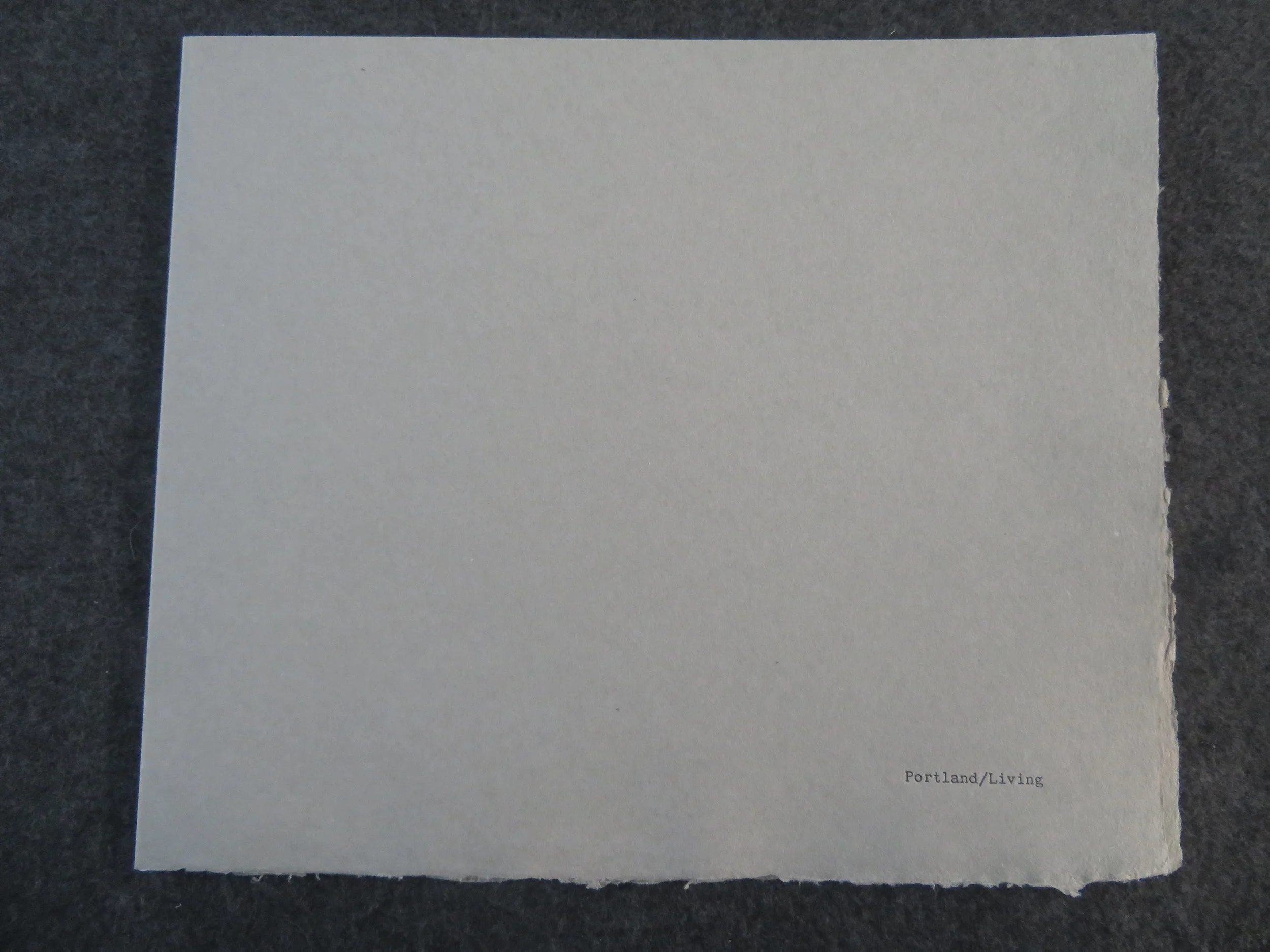
Portland/Living
Images of homeless encampments taken from my daily commute in Portland, Oregon, translated onto thin Kozo paper with pochoir technique. Quotes from members of homeless population collected by Jill Severn. Text is set in American Typewriter and printed letterpress in an edition of 20 copies. 2018

Portland/Living
Images of homeless encampments taken from my daily commute in Portland, Oregon, translated onto thin Kozo paper with pochoir technique. Quotes from members of homeless population collected by Jill Severn. Text is set in American Typewriter and printed letterpress in an edition of 20 copies. 2018
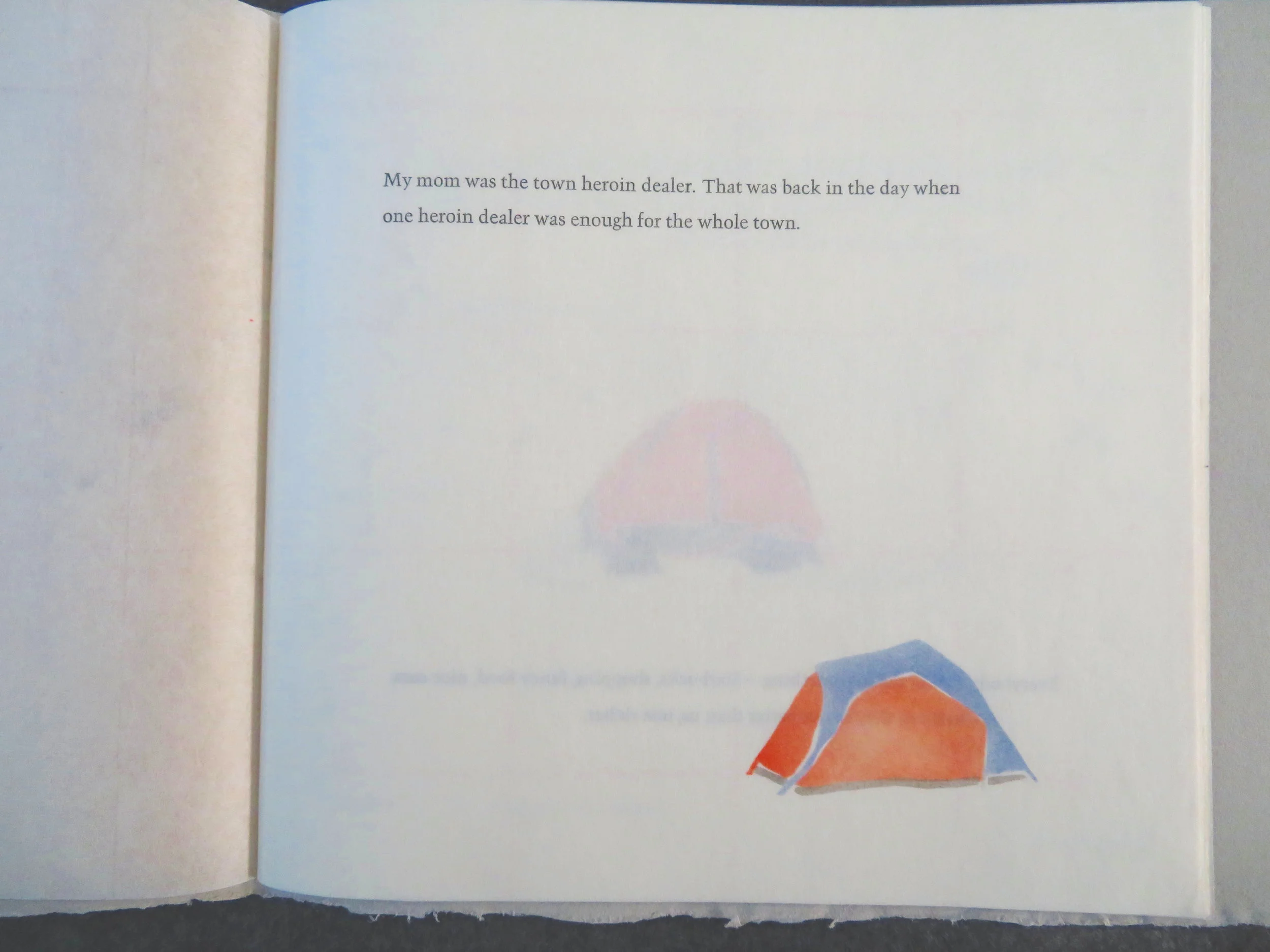
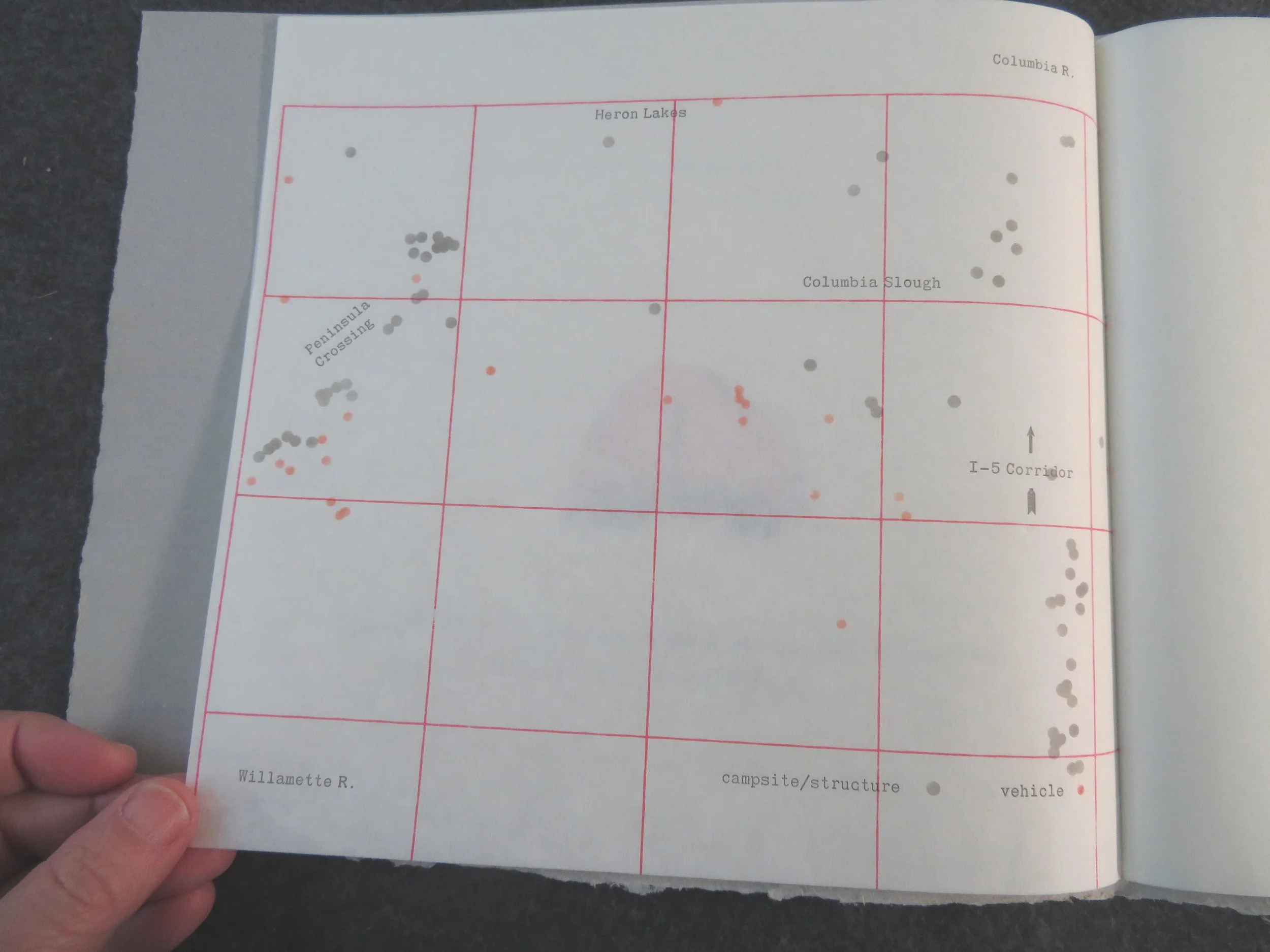
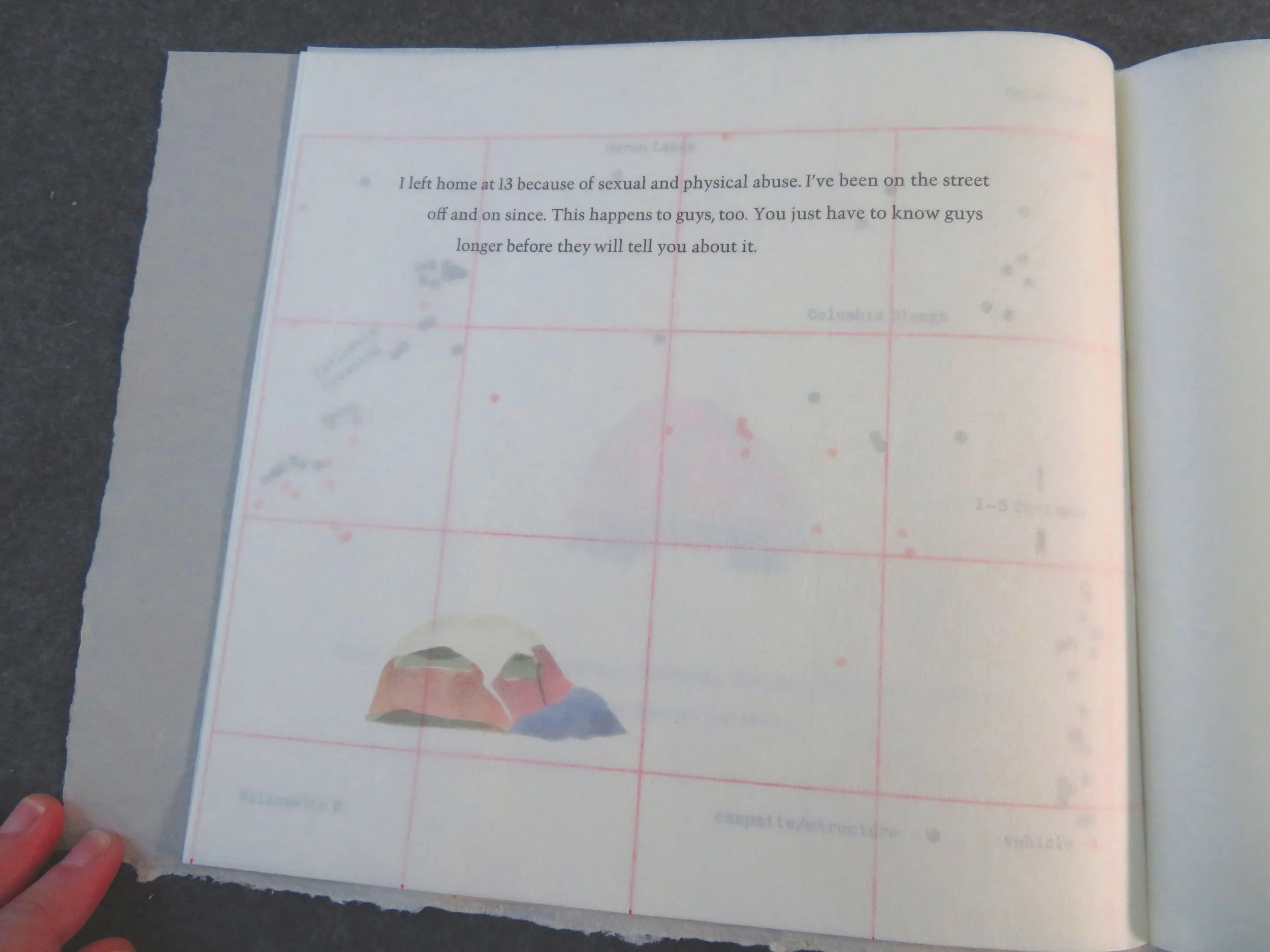



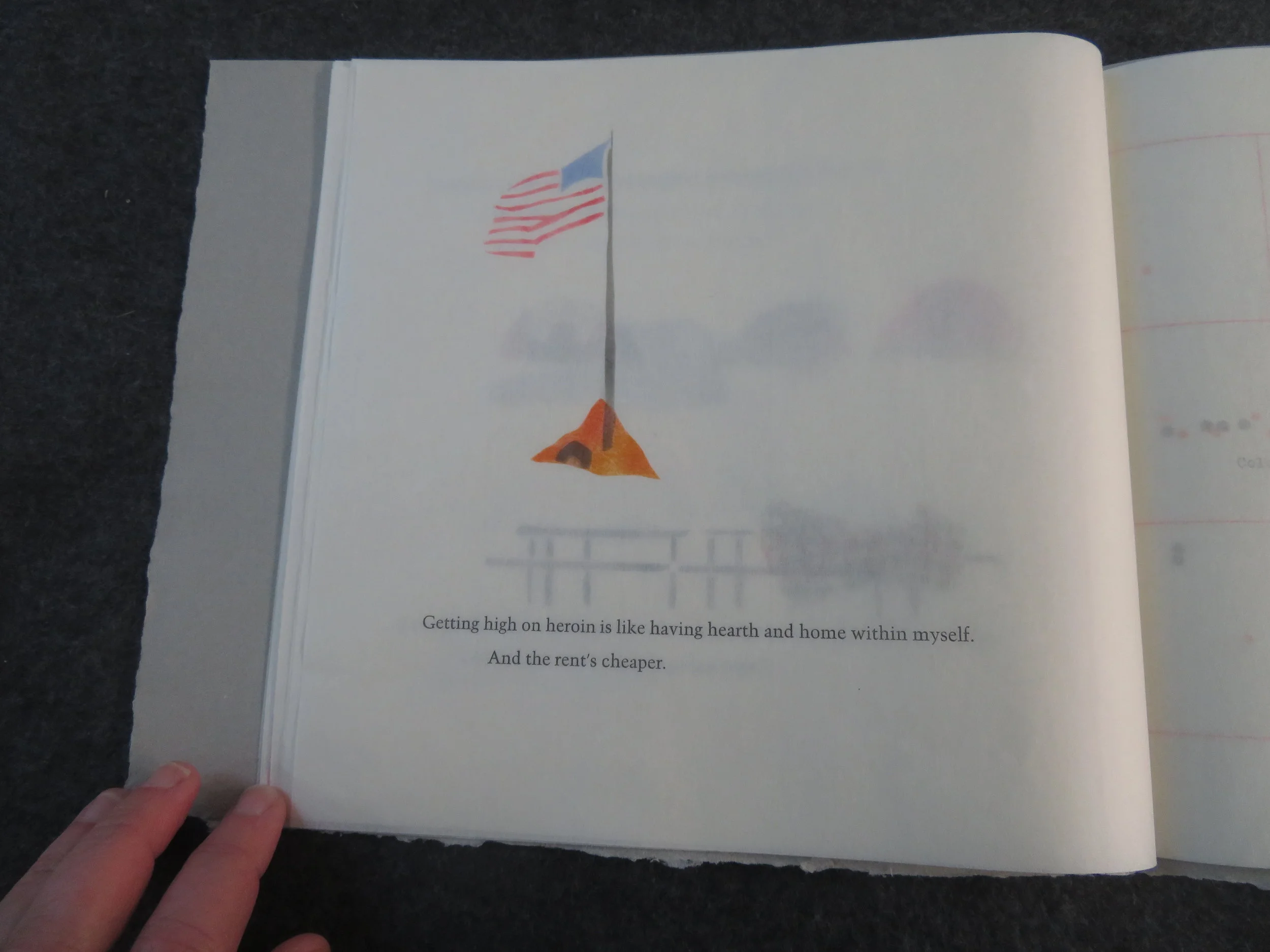
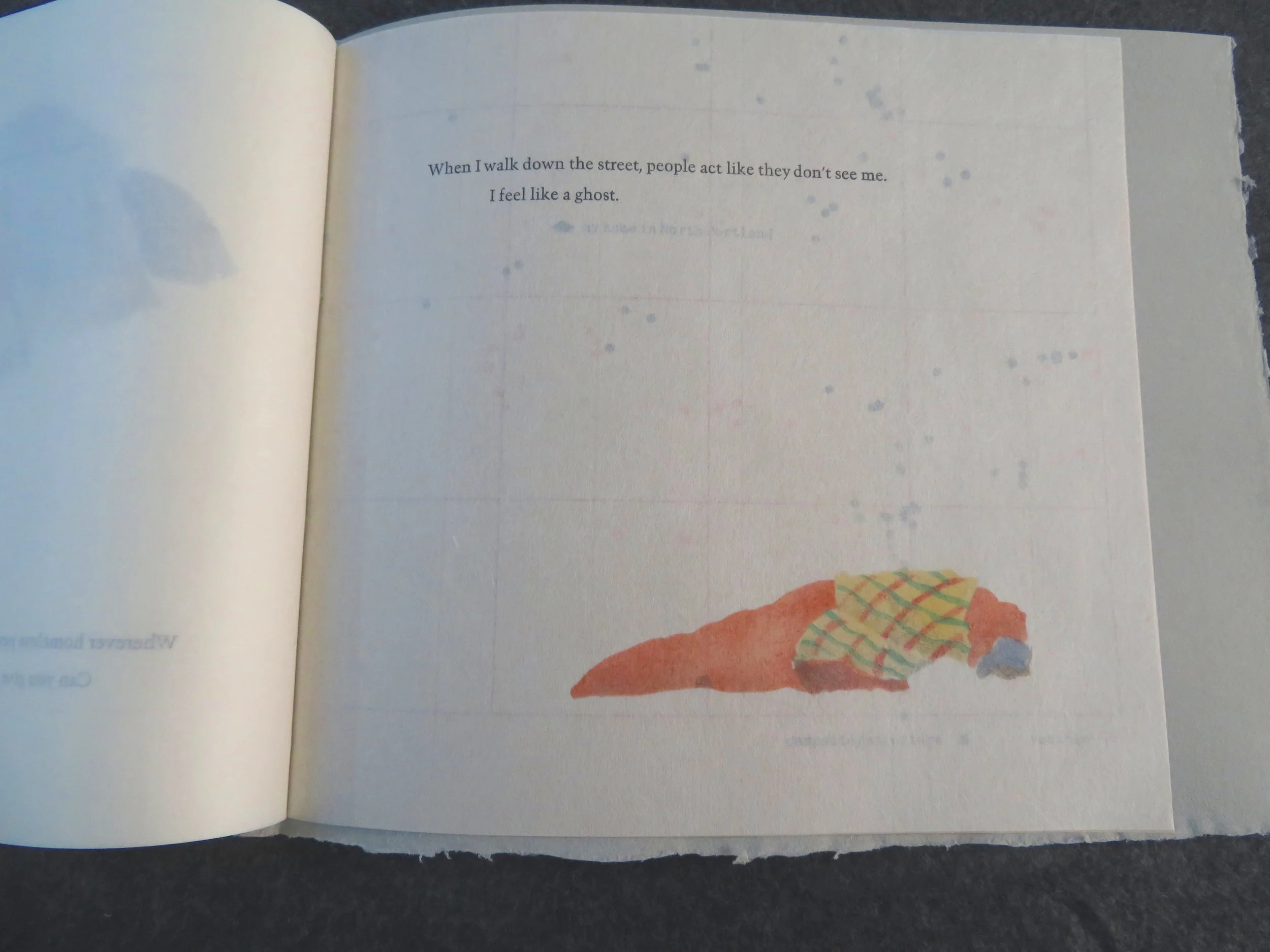

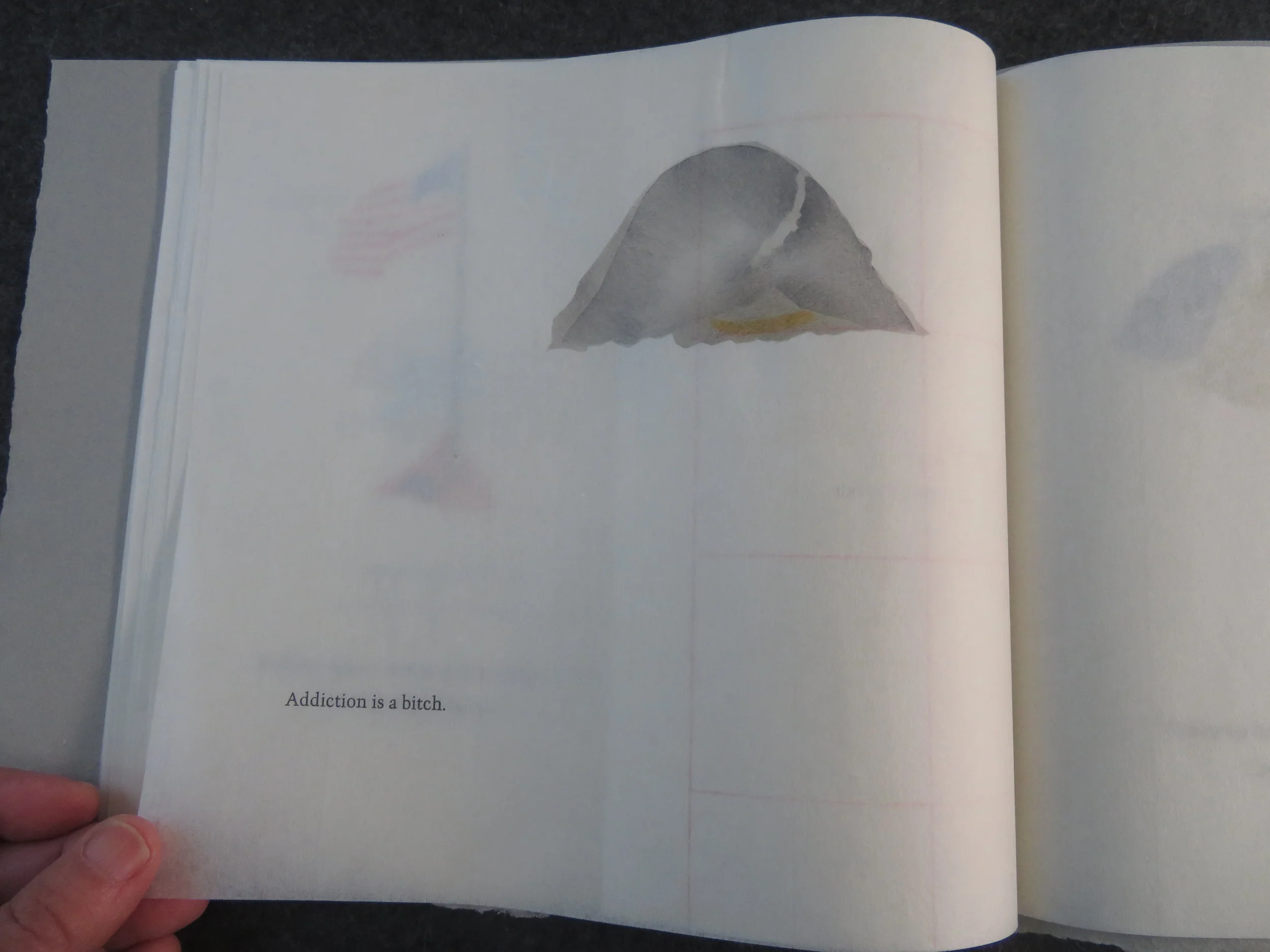
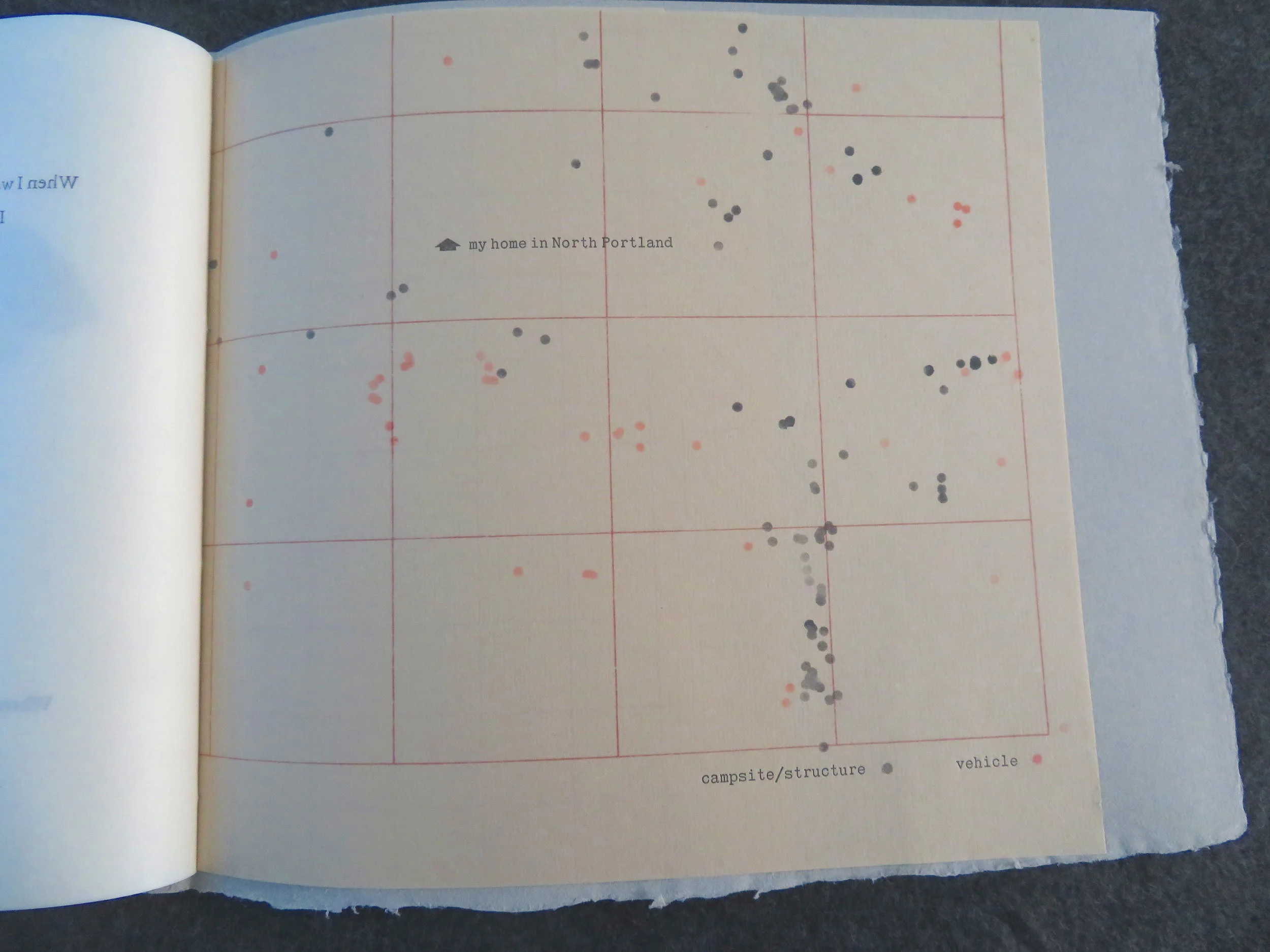

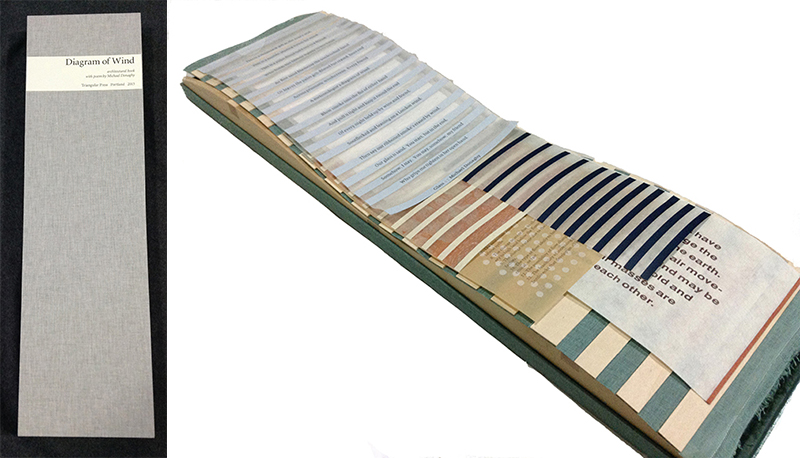
Diagram of Wind
A meditation on the dynamics of wind and wave. This unusal ‘book’ has staggered pages stitched to a length of canvas and wood, which lays over an undulating wooden base. Each page has a unique articulated movement and accompanying sound. Texts include a poem by Michael Donaghy. Project is 19.5 inches long and 6 inches wide. Edition of 25 copies. 2015

Gymnopaedie #5; A Day Without Words
Text and image by Barb Tetenbaum
The text came from a piece of writing made while on sabbatical in Leipzig, Germany in 2009, pondering the inability to silence painful thoughts connected to my life in Portland, 5235 miles away. The images came out of a different motivation: a desire to create a private visual space to calm my nerves during the stressful political campaigns. These two seemingly separate emotional investigations decided to come together in this book.
Media/Materials: Hand-set Meridien type and printer's ornaments, pressure printing into shaped vinyl relief plates, all techniques were printed letterpress onto Zerkall papers in an edition of 33 copies. Bound into a hybrid codex/accordion structure.
Dimensions: 6 3/8" x 4 3/4" x 3/8" closed 2016

Reading Emerson's 'Circles'
During a 2-week residency at Caldera, near Sisters, Oregon I rewrote Ralph Waldo Emerson's essay "Circles" using a special pen that leaves a hard raised mark if you go slowly enough. I wrote out 23 pages which took nearly 30 hours. I did this to accomplish three things: to force myself to read Emerson's essay very slowly; to record distractions and thoughts that I had while reading his words; to create a surface that I would later use to print an edition of artist books using a technique I developed and call "Pressure Printing". Pressure printing uses a low relief plate (my Emerson writings) which is put underneath the paper to be printed (tissue paper) and then run through the letterpress over a type-high inked block. This allows the low relief image to grab more or less ink from the block as it rolls over it. I have now printed an edition of 30 copies of all the pages I wrote out. My thoughts and distractions will be laser printed on transparent paper and interleaved within the book to show that reading is rarely a linear experience, but much fuller experience unique to the reader.
All printing and binding completed by Barb Tetenbaum at Triangular Press. Edition of 25 copies. 2014

Reading Emerson's 'Circles'
During a 2-week residency at Caldera, near Sisters, Oregon I rewrote Ralph Waldo Emerson's essay "Circles" using a special pen that leaves a hard raised mark if you go slowly enough. I wrote out 23 pages which took nearly 30 hours. I did this to accomplish three things: to force myself to read Emerson's essay very slowly; to record distractions and thoughts that I had while reading his words; to create a surface that I would later use to print an edition of artist books using a technique I developed and call "Pressure Printing". Pressure printing uses a low relief plate (my Emerson writings) which is put underneath the paper to be printed (tissue paper) and then run through the letterpress over a type-high inked block. This allows the low relief image to grab more or less ink from the block as it rolls over it. I have now printed an edition of 30 copies of all the pages I wrote out. My thoughts and distractions will be laser printed on transparent paper and interleaved within the book to show that reading is rarely a linear experience, but much fuller experience unique to the reader.
All printing and binding completed by Barb Tetenbaum at Triangular Press. Edition of 25 copies. 2014
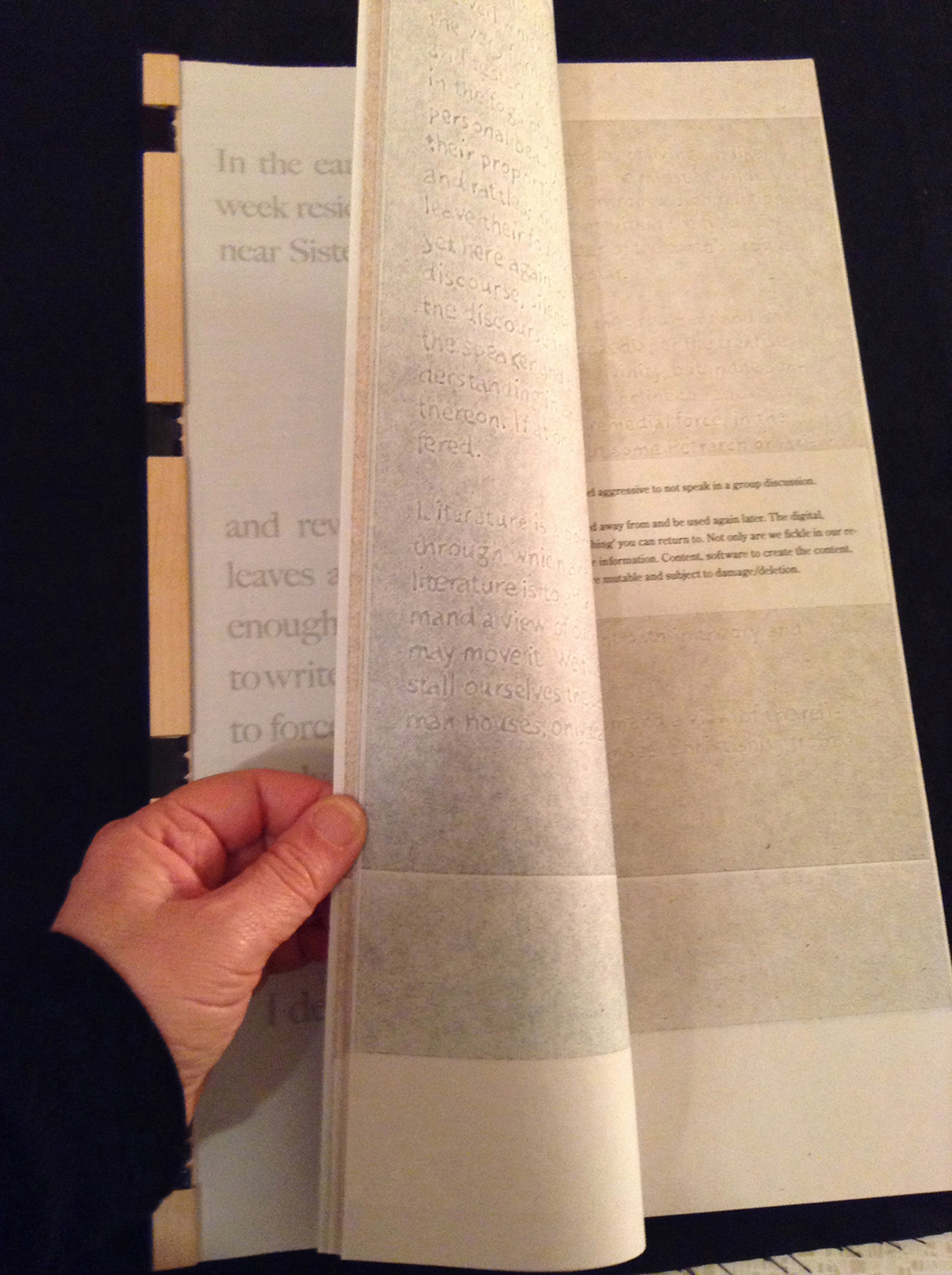
Reading Emerson's 'Circles'
During a 2-week residency at Caldera, near Sisters, Oregon I rewrote Ralph Waldo Emerson's essay "Circles" using a special pen that leaves a hard raised mark if you go slowly enough. I wrote out 23 pages which took nearly 30 hours. I did this to accomplish three things: to force myself to read Emerson's essay very slowly; to record distractions and thoughts that I had while reading his words; to create a surface that I would later use to print an edition of artist books using a technique I developed and call "Pressure Printing". Pressure printing uses a low relief plate (my Emerson writings) which is put underneath the paper to be printed (tissue paper) and then run through the letterpress over a type-high inked block. This allows the low relief image to grab more or less ink from the block as it rolls over it. I have now printed an edition of 30 copies of all the pages I wrote out. My thoughts and distractions will be laser printed on transparent paper and interleaved within the book to show that reading is rarely a linear experience, but much fuller experience unique to the reader.
All printing and binding completed by Barb Tetenbaum at Triangular Press. Edition of 25 copies. 2014
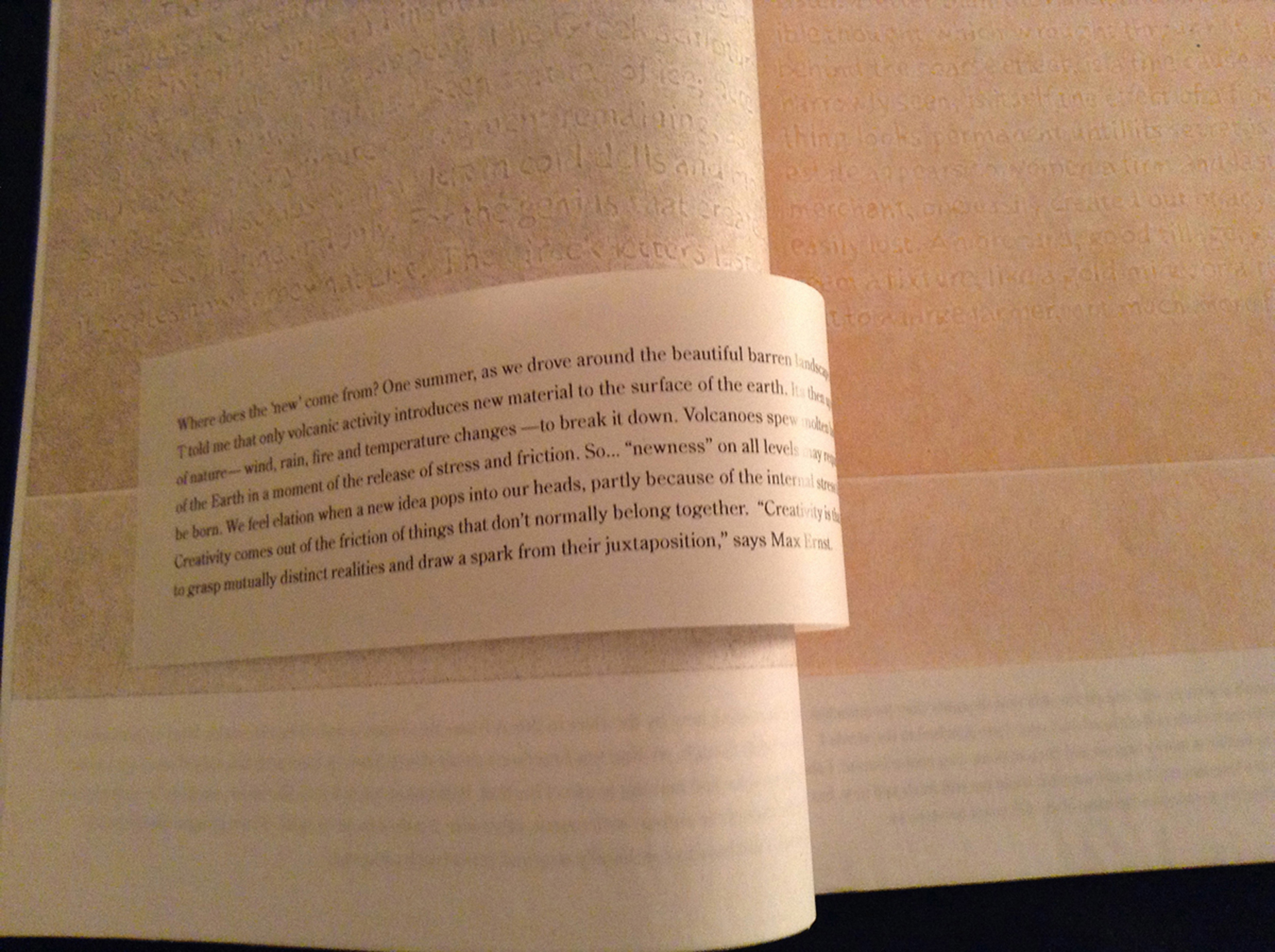
Reading Emerson's 'Circles'
During a 2-week residency at Caldera, near Sisters, Oregon I rewrote Ralph Waldo Emerson's essay "Circles" using a special pen that leaves a hard raised mark if you go slowly enough. I wrote out 23 pages which took nearly 30 hours. I did this to accomplish three things: to force myself to read Emerson's essay very slowly; to record distractions and thoughts that I had while reading his words; to create a surface that I would later use to print an edition of artist books using a technique I developed and call "Pressure Printing". Pressure printing uses a low relief plate (my Emerson writings) which is put underneath the paper to be printed (tissue paper) and then run through the letterpress over a type-high inked block. This allows the low relief image to grab more or less ink from the block as it rolls over it. I have now printed an edition of 30 copies of all the pages I wrote out. My thoughts and distractions will be laser printed on transparent paper and interleaved within the book to show that reading is rarely a linear experience, but much fuller experience unique to the reader.
All printing and binding completed by Barb Tetenbaum at Triangular Press. Edition of 25 copies. 2014

Glimpse
Short description: Glimpse is a collaboration between two artists inspired by a conversation about how a person translates their life experience into a narrative. Prominent events may stand out as the nameable moments, yet it is the space between these events that life, in fact, is lived.
The mid-century photo album structure contains text written by one of the collaborating artists, examining this question. This text is printed on both surfaces of each of the fifteen hinged sleeves. Windows in the sleeves reveal small glimpses of pull-out cards, each written and printed by the other collaborating artist, and containing dates and events of the non-important moments of life. Diagrams, grids, and mundane imagery support these texts.
2011 100 copies
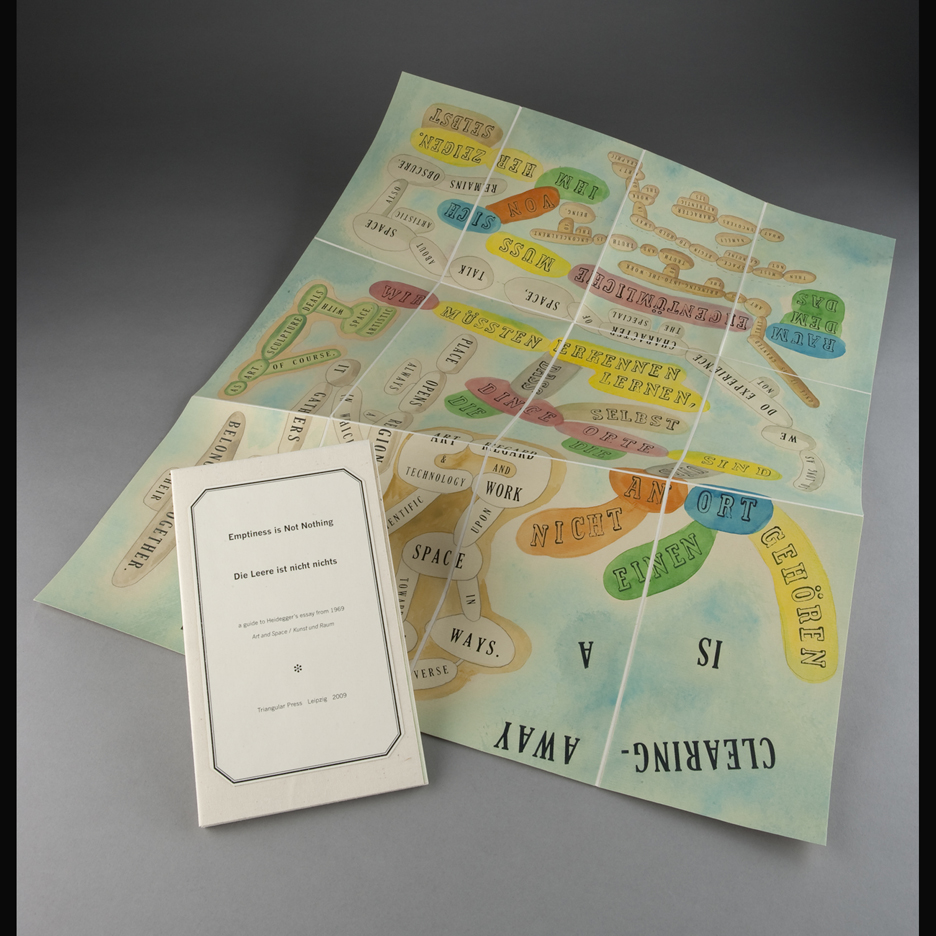
Emptiness is Not Nothing
This artist map is a response to Martin Heidegger’s essay “Art and Space” (Die Kunst und der Raum) originally published in 1969. In the essay, Heidegger explains his new understanding of space after viewing the sculpture of Eduardo Chillida that led him to the realization that space is something unto itself and is given its special character in the presence of art. Offering a mode of way-finding through Heidegger’s obtuse language, I also turned Heidegger’s words back into a visual form using my own method of sentence-diagramming. 2009
Silkscreen and hand applied watercolor on paper, backed with linen.
30" x 20" unfolded

A Powerfully Exciting Short Story; Vibrantly Illustrated with Woodcuts
A small book explaining to the reader their experience of reading a short story and seeing related woodcuts. Powerfully Exciting Short Story plays with the willful imagination of the readers to envision any story written in the pages of a book. The 'story' has no real information and the 'illustrations' are pale suggestions in text only. 2008 3.75” x 6.75” closed. Laser print, case binding, edition of 100.

A Powerfully Exciting Short Story; Vibrantly Illustrated with Woodcuts
A small book explaining to the reader their experience of reading a short story and seeing related woodcuts. Powerfully Exciting Short Story plays with the willful imagination of the readers to envision any story written in the pages of a book. The 'story' has no real information and the 'illustrations' are pale suggestions in text only. 2008 3.75” x 6.75” closed. Laser print, case binding, edition of 100.

Collage Book #5
Unique book made of actual and digitally printed collage pages, interspersed with my voice encouraging you where to look. 2006
Portfolio of Artwork by Barbara Tetenbaum
The following images are book projects starting with the most recent and going back aprox. ten years. Click on the image for information about each project.





























